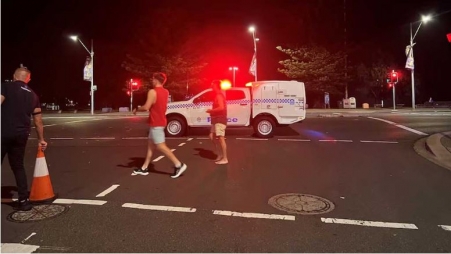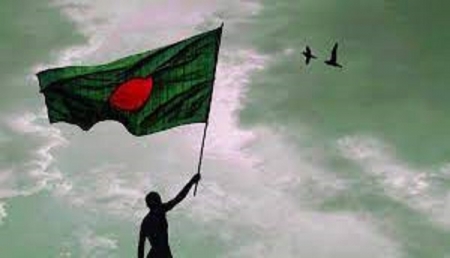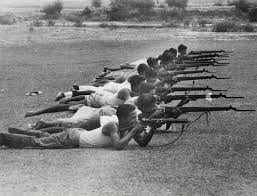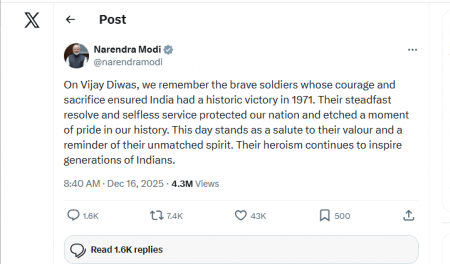THEORY OF STRATEGIC PARALYSIS
COST EFFECTIVE OPTION IN FUTURE CONFLICTS
-Wing Commander Munim Khan Majlish,psc
Bimansena, (BAF Journal), Volume-46, December 2013
“Machines don’t fight war; Terrain doesn’t fight war, Human fight war. We must get into the mind of humans. That’s where the battles are won.”
-Colonel Jhon Boyd
Introduction
1. My niece Ananya was faced with the greatest challenge of her life when she discovered that her newly born younger brother Anik was getting all the attention of their parents. She then used her brain power, not the strength to achieve her objectives. She started keeping away the infant new comer from her companion and pleasure of her secret toys’ treasure. Thus she drew attention of her parents toward her and forced them to change their behaviour by incapacitating her rival in the family. Likewise after the advent of the unique capability- the ‘Air Power’; theorists had experimented to achieve the objective of the war not by destructions only; rather by changing the behaviour of enemy by exploited the air weapon’s inherent characteristics of flexibility and ubiquity.
2. The air power theory has been shaped along lessons learned through wars and visionary concepts of a few pioneer strategists. Wars are obviously costly and fierce in terms of loosing of lives and treasures. That is why throughout the history, this fundamental truth of waging war had driven military strategists to search for a rapid and inexpensive way of victory in battle. The air warriors had also focused their attention on this particular aspect and were determined to seek the inexpensive way to achieve decisive victory. But it has been only recently that airpower technology, employment, and doctrine have been able to project its unique capability in war. Modern strategists have shown the path to achieve the final objective in any military conflict- a change in the enemy government's behaviour by exploiting air power. The modern day’s theorist Jhon Warden has significantly contributed to this evolution through his works on ‘Strategic Paralysis. Thus a new definition of warfare has been discovered in front of the mankind.
3. Economists endeavour to solve the dilemma of achieving maximum profit with minimum investment. Similarly, strategic paralysis is indeed a new military option with physical, mental and moral dimensions, which intends to disable the adversaries rather than destroy the enemy strengths. It seeks maximum possible political effect or benefit with minimum necessary military effort or cost. It certainly aims at rapid political decision of enemy through a manoeuvre battle directed against an adversary’s physical and mental capability to sustain and control its war efforts in order to diminish its will to fight. The objective of strategic paralysis is to attack or threaten selectively those National Elements of Value (NEV) targets that most directly support the enemy's war making ability and its willingness to continue waging the war. The aim is to apply the near simultaneous shock to enemy's central nervous system necessary to persuade strategic paralysis by targeting all societal elements or NEV of enemy. Strategic paralysis strategy brings a change in the enemy's total behaviour.
4. War strategists like Clausewitz or Jomini had correctly realized the significance of vital targets behind the front lines. But they could do nothing due to lack of reach or means to bypass the fielded force. Airpower offered a complete new dimension of warfare to bypass the forces at the front line. It allowed assessing the vulnerability and significance of everything a country held dear. But the air power thinkers wrestled with the dilemma of selecting the best options of targeting by aerial attack. Contemporary air power theorist John Warden revealed an innovative perception of paralysing an enemy’s war efforts rather than causing ruthless destructions. He mentioned, “A strategist should think in terms of paralysing, not of killing”. Warden defines the enemy as a system of five strategic rings and argued in paralysing of these rings by air attack. These rings are the ‘Leadership’, ‘Organic Essentials’, ‘Infrastructure’, ‘Population’ and ‘Fielded Military Forces’. He explained that the innermost ring- the leadership represents the most vital target. The destruction or the neutralization of enemy’s leadership would incapacitate an opponent, because it is the central processing unit of a country from where all other systems are directed and controlled. If a direct attack against this fundamental “bull’s eye” is not politically, morally or practically feasible or possible, then one should try or induce system paralysis through attack upon the outer rings. The ultimate aim of all strategic attack must be the mind and brain of the enemy’s political power or will. Warden assures that air power alone can paralyse all these five rings by simultaneous or selective attack from the inside out.
Notion of Strategic Paralysis
5. Most military strategists in the past had recognized mainly two fundamental strategies of warfare; attrition and annihilation. Attrition warfare seeks an eventual victory by exhausting the enemy in time, space, energy and supplies. It is indeed rich nations’ business in this world of scarcity. An attrition strategy generally occurs between forces of roughly equal size or capability. It is a strategy of greater durations and cost (loss of both lives and wealth). An annihilation strategy implies superiority over one’s adversary. Here one seeks the complete and utter destruction of the enemy. Such strategy is often costly or indiscriminate and is generally pursued through a strategy of over-whelming force. It is indeed foolish to pursue war of attrition or annihilation for a nation like Bangladesh who is surrounded by superior adversaries. Modern airpower thinkers offer another option- the ‘Strategic Paralysis’. It aims at an earlier and less costly solution by paralysing the enemy’s key sources of strength.
6. The strategic paralysis theory is not a new concept; rather theorists had applied such idea throughout the history of war. Great Chinese thinker Sun Tzu was the first to lay the theoretical foundation of warfare upon which later strategies were formed. He said, “It is better to keep a nation intact than to destroy it, it is better to keep an army intact than to destroy it, therefore those who win every battle are not the really skilful- those who render others armies helpless without fighting are the best of all”. Another great strategist Clausewitz termed the war as absolute and real. He defined the absolute war which focuses on the total annihilation of the enemy. In contrast the real war was the destruction of the enemy’s armed forces- that they must be forced in such a condition that they can no longer continue fighting. As such the real war indirectly advocates for the paralysing of the enemy’s armed forces.
7. British strategist JFC Fuller probably can be termed as the designer of modern day operational plan or campaign plan aimed at enemy paralysis. He stressed, “The physical strength of an army lies in his organization, controlled by its brain. Paralyse this brain and the body would cease to operate”. He also stressed that the most potent and economical way of warfare is the disarmament through paralysis rather than destruction through annihilation. Fuller envisaged the war as “A friendly army holding at bay whilst its aircraft are destroying the hostile communications and bases and so paralyse the enemy’s all possible action; thereby the enemy would be incapacitate and cease its operations”. It is probably the best suitable strategy for Bangladesh to encounter its massive adversaries.
8. British renowned strategist Basil H. Liddell Hart underscored the importance of paralysing an enemy by air, so as to win wars at the lowest possible cost. He emphasised that it was more persuasive and more economical to disarm the enemy than to attempt its destruction by hard fighting. He advocated considering in terms of system paralysis, not destructions. Liddell argued that “A man killed is merely one man less, whereas a man unnerved is a highly infectious carrier of fear, capable of spreading an epidemic of panic. This fear can spread to the higher levels of command, as well, even to the mind of the enemy commander nullifying the whole fighting power that his troops possess.”
9. Air force is a way of life chosen by a group of people to defend the sovereignty of motherland. Accordingly, Warden’s strategic paralysis theory is a way of waging and winning war by exploiting airpower. It is more political than economic in nature. Targeting the enemy leadership to happen the desired policy change is the main objective of this approach. Warden emphasised to attack where the enemy is most vulnerable and the point where an attack will have the best change of being decisive. Thus strategic paralysis is achieved by attacking an enemy’s not every target, but the most important elements (leadership, industry, armed forces, the population’s will or morale, transportation, communications and alliances). Warden advocated that the most effective strategic plan focuses on leadership first and foremost. If the leadership is not available as a target set, the strategist must still focus on the mind of the commander when selecting centre of gravity (COGs) among the other rings. The destruction or the neutralization of the leadership will cause total physical paralysis of the system, whereas successful attack upon COGs within other rings will produce partial physical paralysis, but will create unbearable induced psychological pressure upon the leadership.
10. Any war mechanism is the ultimate outcome of achieving the political objectives of a nation. It is a series of functions related to Ends, Ways and Means of attaining those ultimate objectives. Air power strategist endeavours to convince the political leadership to employ airpower in accomplishing its grand objective. Air power’s modern thinkers had translated this method in the following approach:
a. Ends. All wars are fought for political purpose, and such political objective is being sought by military action.
b. Ways. The best military strategy to induce the enemy to comply with ones will as defined by those political objectives. The three main ways to induce the enemy could be: impose cost (attrition), paralysis (incapacitation), and destruction (annihilation).
c. Means. The use of five-ring system to identify which NEV or COGs of the enemy is to be considered for parallel attack. A paralysis strategy seeks to make continued resistance impossible for the enemy command. It does so by thoroughly and simultaneously incapacitating the entire enemy system from the inside out.
Exploitation of Paralysis Theory
11. Douhet termed them as ‘vital centres’, Curtis LeMay ‘vital targets’, Jomini referred to them as ‘decisive strategic points’, Bomber Harris labelled them ‘panacea targets’, Liddell Hart identified as the enemy’s ‘Achilles heel’, Billy Mitchell said they were ‘nerve centres’, and Clausewitz emphasised them ‘centres of gravity’. Actually all the great strategists of warfare were referring to the same phenomena- the decisive targets. Military thinkers had always looked for the vital targets that assured them a quick and decisive victory. That is why they had endeavoured to sort out a single target or set of targets that once destroyed or incapacitate yields victory. After the advent of airpower its great strategists like Douhet or Mitchell for the first time in the history of warfare had shown that the search for a decisive target is actually over. By exploiting the unique ability of airpower to strike directly at the enemy’s heart, bypassing its surface forces the enemy’s war making abilities can be paralysed and thereby force the enemy to alter its behaviour. Then onward strategists had successfully employed airpower in establishing the theory of strategic paralysis.
12. Strategic paralysis offers several benefits over those of conventional attrition and annihilation war strategy. The most important of all is that it is less costly. ‘Operation Desert Storm’ was the first use of strategic paralysis. The USA could have invaded Iraq at great cost or easily by carpet bombing Baghdad. But it adopted a surgical approach by attacking only the key NEV. By doing so, the conflict was shortened, casualties were kept lower on both sides, and precious money was saved. Such approach also appeals the world community of 21st century who naturally dislike any long and bloody conflicts. The concept of paralysis strategy had been transformed with the advent of new technology as well as in changing atmosphere. We will discuss the evolution of paralysis strategy in subsequent paragraphs.
13. The Past: Paralysis by Economic Warfare and Industrial Targeting. British theorist Hugh Trenchard opted to incapacitate the enemy by attacking vital COGs like war making potential, production, transportation and communication from which the enemy war efforts were sustained. He emphasised the moral effect of such attacks more than the physical destructions or effects. He argued that air attacks would terrorise munitions workers into abstaining themselves from work, or workers from abandoning the loading of ships with munitions from fear of aerial attack. He preferred to produce strategic paralysis by means of the psychological terror that were ensured from economic disruption and collapse.
14. The Present: Paralysis by Control Warfare and Command Targeting. Present day theorist Warden advocates for paralysing enemy’s will to fight through control warfare based on incapacitation of enemy command, system of governance, information processing, decision making and action taking process. Here the physical massacre of the people or the total destructions of the industries or armies and the psychological terrorising of the population are not ultimate objectives or means. The ultimate objective is to exploit the unique characteristics of air power to paralyse an enemy’s ability and will to continue the war.
15. The Future: Paralysis by Control Warfare and Information Targeting. Any future war would be by Inducing strategic paralysis by attacking (physically or electronically) key information related COGs. In future high tech atmosphere defeating the collection or dissemination of the information will be practically the same as of destroying the attacking platform itself. At present decentralization or the vertical to horizontal power shift is taking place due to the technological advancement. A person or leadership will not be a vital element in future conflict; rather a system guided by sophisticated electronic devices would control the decision making of a nation or the world order itself. Indeed future paralysis theory would be waging war simultaneously in three combined dimensions–economic warfare based on industrial targeting; control warfare based on vertical command targeting; and control warfare based on lateral information targeting. Warden’s bull’s eye would lose its significance and will be less relevant in future. Thus the pre-emptive employment of forces may become prerequisite in future. Who ever cease the initiative would be decisive in future conflict.
Critiques
16. Apart from the discussions so far some differing thoughts are also prevailing. In the theory of strategic paralysis, airpower is employed to accurately strike at an enemy’s National Elements of Value (NEV) or COGs; so as to paralyse enemy’s ability to continue the conflict; and perhaps even break its will of waging war. The desired result is actually a change in enemy’s behaviour. To achieve success by adopting strategic paralysis, it requires four key ingredients: the right targets, high technology, an enemy dependent upon a well developed, modern and vulnerable infrastructure, and aerospace control. Very few nations or its adversaries in the world can indeed afford to have such capability. Again many scholars claim that the leadership is not always the most important target. The leadership may decide one aspect; but the population or the armed forces may opt for another strategy. Thus the true COGs or what matter most to the enemy as a whole may not follow the rule of five rings theory. This will vary significantly amongst the nations depending on many factors like political structure, economy, society, social structure, infrastructure, religion etc.
17. Some argue that moral is to the physical as three is to one. But Warden thinks that the enemy’s combat effectiveness is just the multiplication of physical and moral strength. And it is easier to attack physical target than destroying enemy’s moral or will to fight. Physical destruction is conceptually countable or knowable. But in reality it is not at all possible to constrain enemy’s physical existence to zero.
18. Paralysis strategy deals with unilateral action taken against an unresponsive enemy and thus disregards the action–reaction cycles. While theoretically possible, it is difficult to imagine the real war that is reaction less. Despite the total incapacitating of Saddam’s Regime the Iraq conflict is not yet over even after 19 years. If human nature is the controlling element of warfare then the war will ever remain unpredictable.
Conclusion
19. Wars are fought for political purpose. Here the political objectives are being sought by military action. Three main ways could be adopted to induce the enemy to comply with one’s will as defined by those political objectives: impose cost (attrition), paralysis (incapacitation), and destruction (annihilation). Modern strategists have suggested employing strategic paralysis as the way of fighting and winning wars by exploiting airpower as an alternative to the traditional strategies of either attrition or annihilation.
20. The airplane promised the means (massive fire power, reach and mobility) necessary to break the deadlock of land warfare. As the airplane improved and its weapons became more lethal and accurate, another strategy for its use became apparent that suggested a less costly way of waging war. Strategic paralysis focuses on a country’s most critical targets or NEV. Using the advancement of high technology, strategic paralysis uses airpower to incapacitate enemy’s ability and will to continue the fight. ‘Operation Desert Storm’ was the first example of successfully applying strategic paralysis. Attacks from the air at the right targets with minimum exposure to the enemy, strategic paralysis will decisively bring end to any future conflict and prevent high casualties (on both sides), high cost, and long duration warfare.
BIBLIOGRAPHY
1. David S. Fadok, John Boyd And John Warden: Air Power's Quest For Strategic Paralysis, Air University, Maxwell Air Force Base, Alabama, June 1994
2. Allison, Graham T, Essence of Decision, Boston: Harper Collins Publishers, 1971.
3. Clausewitz, Carl von, On War. Edited and translated by Michael Howard and Peter Paret, Princeton, NJ: Princeton University Press, 1976.
4. Douhet, Giulio, The Command of the Air. Translated by Dino Ferrari, Washington, D.C.: U.S. Government Printing Office, 1983.
5. Fuller, J.F.C, The Foundations of the Science of War, London: Hutchinson and Company, 1925.
6. Hallion, Richard P, Storm Over Iraq. Washington, D.C.: Smithonian Institute Press, 1992.
7. Sun Tzu, The Art of War, Translated by Thomas Cleary. Boston & London: Shambhala Publications, Inc., 1988.
8. Warden, John A. III, The Air Campaign, Washington, D.C.: National Defence University Press, 1988.
9. Auspex, Victory from the Air. London: Whitefriars Press Ltd., 1941.
10. Ayling, Keith. Bombardment Aviation. Pennsylvania: Military Service Publishing Company, 1944.
BIODATA
1. Wg Cdr Munim Khan Majlish,psc was born in 27 October 1968 in Dhaka. He joined BAF in 1988 and got commissioned in 03 January 1991 in the ATC branch. He attended number of professional courses home and abroad. He is a cat B1 R Air Traffic Controller with GCA rating. He is a Mirpurian and graduated from DSCSC in 2002. He had participated in the UN Peacekeeping Operation in DR Congo as a member of Bangladesh ASU contingent. He was amongst the pioneers of successfully taking over the control of Bunia Airport from the IEMF before deployment of UN forces at DR Congo. Widely travelled person Wg Cdr Munim visited Turkey, UAE, USA, Thailand, Malaysia, DR Congo, Uganda, Zambia, Zimbabwe, South Africa and India. He had learned Turkish language and a little bit of French, while he was abroad. Literature and cricket are his likings. He is married and proud father of his lovely son. Currently he is serving as the SATCO of ATC Sqn of BAF Base Matiur Rahman.
সর্বশেষ এডিট : ২৭ শে সেপ্টেম্বর, ২০১৭ দুপুর ১:৪০


 অনুগ্রহ করে অপেক্ষা করুন। ছবি আটো ইন্সার্ট হবে।
অনুগ্রহ করে অপেক্ষা করুন। ছবি আটো ইন্সার্ট হবে।








